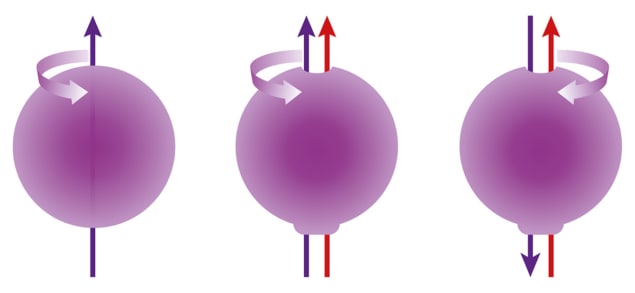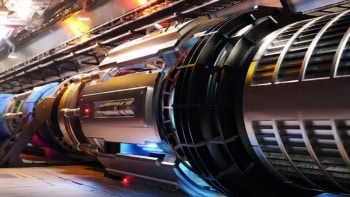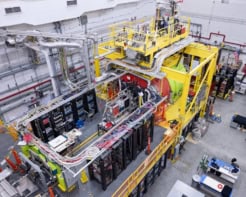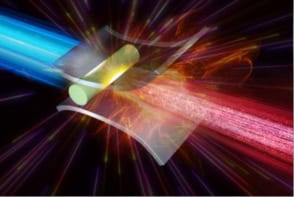
For more than 60 years, physicists have been searching for a miniscule separation of charge within the neutron known as an electric dipole moment. Finding this “neutron EDM” would be a major discovery, in part because it could help explain why matter in the universe did not simply become annihilated along with antimatter at the dawn of time. For the moment this dipole remains hypothetical, but new results obtained after painstaking observations of cold neutrons give us a better idea of just how small it would have to be – lowering the previous upper limit by 40% (arXiv:2001.11966).
Although the neutron has no overall charge, a conundrum that has long baffled physicists suggests the particle nevertheless contains a region that is very slightly positive and another that is ever so slightly negative. That problem is the imbalance of matter and antimatter in the cosmos. The imbalance could be explained via the existence of processes that violate what is known as charge conjugation parity (CP) symmetry, but such violation within the Standard Model of particle physics is too limited to account for the overwhelming dominance of matter that we see around us.
Pointing the way
According to Dave Wark of the University of Oxford in the UK, who was not involved in the latest work, a neutron EDM would be “a signpost” of new physics beyond the Standard Model that might account for the matter-antimatter imbalance. That’s because the phenomenon would violate temporal (T) symmetry, and in turn CP-symmetry (the combined CPT being invariant). While a neutron’s spin magnetic moment would change when the flow of time is reversed, an EDM, if it existed, would not – meaning that the relationship between the two properties would change under such a reversal. (This is also true of other particles, and indeed some groups are hunting a possible electron EDM.)
In searching for the tiny putative effect, physicists rely on the fact that an EDM would cause a neutron’s spin axis to rotate when exposed to an electric field. To pick out this rotation they first place neutrons in a constant magnetic field, which itself sets the spin axes rotating. They then measure the particles’ precession frequency and do so again after applying a large electric field. If the neutrons really do have an EDM then their precession frequency should shift in line with the electric field strength.
Modern experiments use what are known as “ultra-cold” neutrons. These have such a low energy that their de Broglie wavelength is much longer than the distance between atoms, allowing them to be confined inside a material container over relatively long periods of time – typically several minutes. This increases experimental sensitivity. The most precise measurement until now had been made using neutrons from a reactor at the Institut Laue–Langevin (ILL) in Grenoble, France.
In 2006 a group of physicists from the ILL and the University of Sussex and Rutherford Appleton Laboratory in the UK reported an upper limit for the EDM of 2.9 × 10-26 e cm. That result was then modified very slightly in 2015 – to 3.0 × 10-26 e cm – after a more detailed analysis of the data by a larger group of researchers.
The latest research has been carried out by a pan-European collaboration led by Guillaume Pignol of the University of Grenoble and Philipp Schmidt-Wellenburg of the Paul Scherrer Institute near Zürich. The new group reused much of the apparatus from the earlier work – which is operated at room temperature – but this time took its neutrons from a spallation source at the Paul Scherrer Institute. It also did more to reduce systematic errors. Ultracold neutrons put a new spin on neutron dipole measurements
As was the case before, the researchers stored neutrons in a chamber also containing atoms of mercury vapour. By measuring the ratio of precession frequencies of the two types of particle they could largely cancel out the effects of any fluctuations in external magnetic fields. But just to ensure they could understand and control the magnetic field as far as possible they also installed a set of caesium magnetometers above and below the chamber. Pignol, Schmidt-Wellenburg and colleagues were able to reduce systematic errors by a factor of five compared to the 2015 result. Collecting data between 2015 and 2016, and performing a series of blind data analyses, they settled on a new, lower upper limit for the neutron EDM of 1.8 × 10-26 e cm.
Pushing the limit
To push the limit further down, researchers have been developing a cryogenic version of the experiment. The idea is to cool neutrons by scattering them off atoms of superfluid liquid helium, so boosting the density of ultra-cold neutrons as well as allowing longer storage times and higher electric fields. Wark says that this approach could yield sensitivities hundreds of times higher than is possible now, providing, he adds, that systematic errors can be controlled “to such a spectacular level”. Wark adds that the ILL group installed such an experiment but “were unable to get all the many parts of it working simultaneously for long enough to make a sensitive measurement”.
That potentially leaves the door open to a US collaboration building a cryogenic experiment at the Oak Ridge National Laboratory in Tennessee, which may start data-taking in 2023.
The paper has been accepted for publication in Physical Review Letters.



